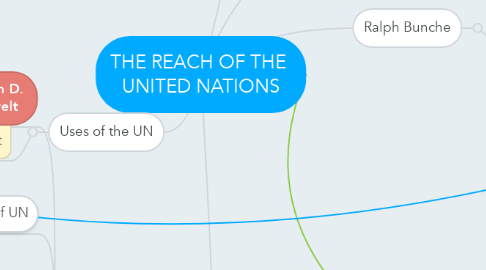
1. Uses of the UN
1.1. They can have diplomatic contact
1.1.1. With all nations
2. The rise of the UN
2.1. Franklin D. Roosevelt
2.1.1. Planned
2.1.1.1. United Nations
2.1.1.1.1. To prevent wars
2.1.1.1.2. To rectify
2.2. Structure of UN
2.2.1. General Assembly
2.2.1.1. Meets every fall
2.2.1.1.1. All nations have one vote
2.2.2. Security Council
2.2.2.1. Can meet any time
2.2.2.1.1. To preserve peace
2.2.3. Secretariat
2.2.3.1. To run the Organization
2.3. Veto
2.3.1. Blocking a measure by just one vote against
2.3.2. The big five
2.3.2.1. United States
2.3.2.2. Russia
2.3.2.3. China
2.3.2.4. Britain
2.3.2.5. France
2.3.3. Has kept the UN alive o lot longer than League
3. Giving peace and chance
3.1. Cease-fire
3.1.1. Mutually agree-upon pause in a war
3.2. ROEs
3.2.1. Rules Of Engagement
3.2.1.1. When peacekeepers may shoot back
3.2.2. Mission creep
3.2.2.1. Tendency of modest peacekeeping goals to expand
4. Theory of Collective Securyty
4.1. Agreement of all countries
4.1.1. Versailles Treaty
4.1.1.1. League of Nations
4.1.1.1.1. Failure
4.1.1.1.2. Weaknesses
4.1.2. Punish aggressor states
4.2. Real aggressors
4.2.1. Disguise their misdeeds
4.3. New world
4.3.1. Defense minister
4.3.2. Everyone is defensive
4.3.2.1. Americans in Iraq
4.3.2.2. Russians in South Ossetia
4.3.2.3. Iraqis in Kwuait
5. Ralph Bunche
5.1. Contribution to PEACE
5.1.1. Proximity Talks
5.1.1.1. Disputants negotiate through a nearby mediator
5.1.1.1.1. Not face to face
5.1.2. Peacekeeping
5.1.2.1. Third-party military forces
5.1.2.1.1. Stabilize a cease-fire
5.1.2.2. Nobel Peace Prize - 1950
6. Funcionalism
6.1. Gaining countries cooperation
6.1.1. Specialized matters
6.1.1.1. General cooperation

